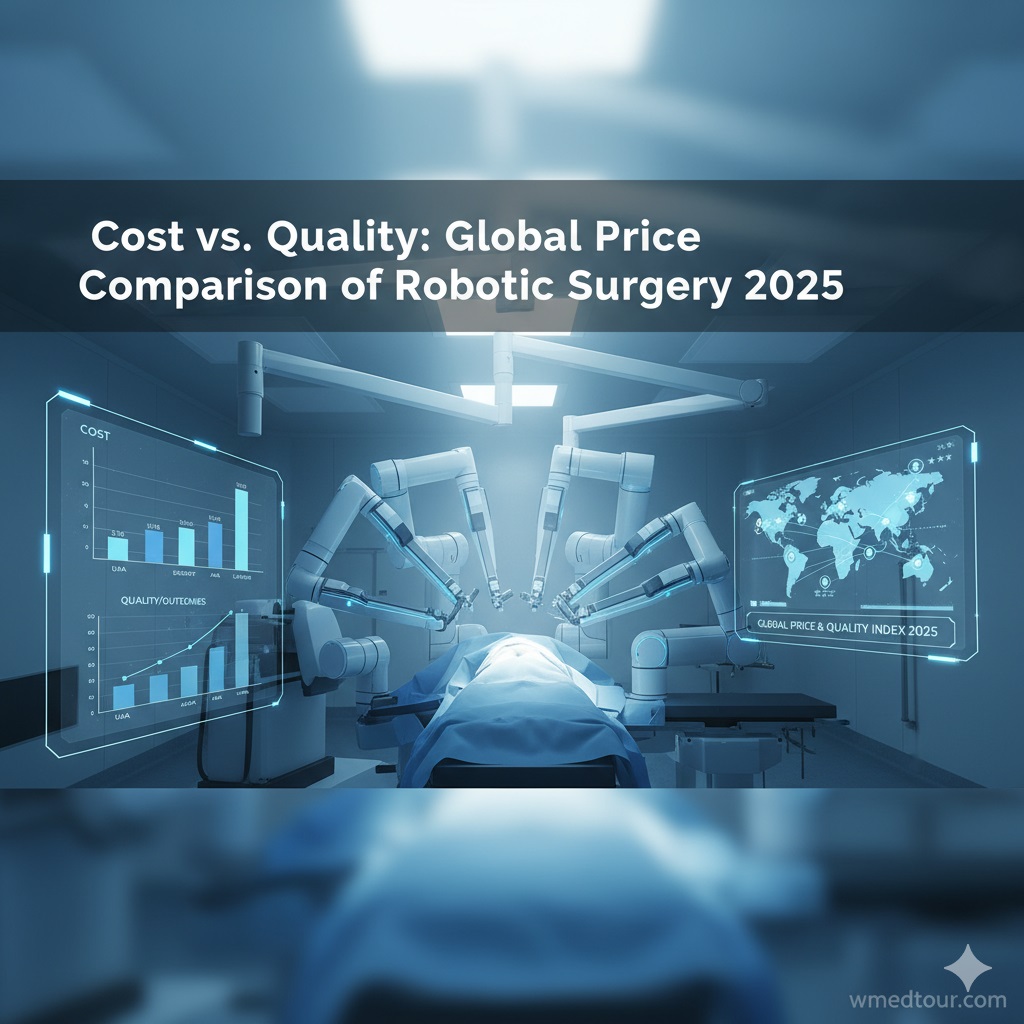Home > Articles > Robotic Surgery
Robotic Surgery Cost vs Quality: The Global Price Comparison
Executive Summary
The global landscape of Robotic Surgery Cost vs Quality presents a fascinating dichotomy. Indeed, this executive summary highlights the key takeaways from our in-depth analysis:
- Price Variance: The cost of robotic surgery can fluctuate by over 300% globally. Nations like the US and Western Europe represent the highest prices. Conversely, emerging medical tourism hubs offer significantly lower rates.
- Quality Drivers: Quality isn’t solely tied to price. Instead, it’s driven primarily by the surgeon’s experience, the hospital’s patient volume, and the robotic system’s maintenance/upgrade cycle.
- Minimally Invasive: Robotic surgery, despite its high initial investment, is becoming the standard for many complex procedures—including prostatectomy, hysterectomy, and cardiac repair. This is due to its minimally invasive nature and improved patient outcomes. Ultimately, this makes the high cost justifiable.
- Key to Value: True value lies in balancing the lower price point of global medical travel with documented, high-volume surgical expertise and accredited facilities. Specifically, patients must target this balance.
- Informed Choice: Patients and professionals must look beyond the initial price tag. Therefore, they must assess comprehensive care, including pre-operative diagnostics and post-operative follow-up.
Robotic surgery represents the pinnacle of minimally invasive technology, transforming complex procedures from routine gall bladder removal to intricate heart bypasses. Clearly, for patients facing major operations, the promise of smaller incisions, less pain, and quicker recovery is immensely appealing. Yet, the price tag associated with this advanced technology can be staggering. Consequently, individuals and healthcare systems face a crucial question: How do we balance Robotic Surgery Cost vs Quality globally? This is a key query for modern medical tourism, as outlined in our comprehensive guide.
This comprehensive guide dives deep into the economics, geography, and clinical outcomes of robotic-assisted procedures worldwide. Furthermore, we’ll explore how the core concept of Robotic Surgery Cost vs Quality is shaped by variables far beyond the operating room. Moreover, we integrate new data to provide an up-to-date assessment.
The Economics of Robotic Surgery Cost
Understanding the global price differences in robotic surgery cost requires an initial look at the core components that drive the price. Transitioning from traditional open or even laparoscopic surgery introduces a massive capital expenditure. Therefore, the discussion on Robotic Surgery Cost vs Quality hinges on these foundational investments. Specifically, three main areas drive this cost.
1. Capital Investment in Robotic Systems
The robotic system itself—often the da Vinci Surgical System—is the primary cost driver. It can cost several million dollars upfront, as confirmed by US healthcare cost data. In addition to this initial outlay, hospitals must continually invest in:
- Maintenance Fees: Annual service contracts are extensive. They ensure the complex machinery remains functional and safe. Undeniably, these recurring fees are substantial.
- Consumable Instruments: The specialized surgical instruments used by the robot have a limited lifespan, often around 10 uses. They must then be replaced, which significantly adds to the cost of every single procedure.
- Upgrades and Training: Regular software and hardware upgrades are essential for staying current. Similarly, continuous training for surgeons, anesthesiologists, and support staff is required. Global medical standards often mandate this rigorous ongoing education, thereby increasing operational overhead.
2. Geographic Economic Factors
The location of your procedure is often the single biggest price determinant. Consequently, a true understanding of Robotic Surgery Cost vs Quality must account for regional economics.
In high-income nations, high labor costs, malpractice insurance, and stringent regulatory environments inflate the price dramatically. Conversely, medical tourism destinations benefit from lower operating overheads. Moreover, these countries often offer government incentives to attract foreign patients, which translates into significantly reduced pricing for the same high-tech procedure. A recent university study on medical tourism illustrates this correlation between local economies and patient pricing. Indeed, this is why cost savings are often realized abroad.
Patient Journey: Daniel’s Robotic Prostatectomy
Daniel, a 62-year-old software engineer from the UK, received a diagnosis of localized prostate cancer. His local specialist recommended a robotic-assisted radical prostatectomy, quoting a private cost of approximately $45,000 (£35,000). However, Daniel sought a more affordable option without compromising quality, so he researched global alternatives. Subsequently, he focused on high-volume centers.
He discovered a highly accredited, university-affiliated hospital in a developing medical tourism hub. The hospital featured the latest generation of the da Vinci system and a surgeon who had performed over 500 robotic prostatectomies. The all-inclusive package, which covered surgery, a 5-day hospital stay, and all pre/post-operative care, cost $18,000. Therefore, he opted for the lower-cost, high-volume center, which demonstrably offered the quality he needed. Daniel’s recovery was swift. He returned home two weeks later, proving that balancing Robotic Surgery Cost vs Quality effectively maximizes patient value. You can read more about prostate cancer treatments abroad here.
The Quality Component: Evaluating Robotic Surgery Quality
A low price is only a good deal if the quality of care remains high. Importantly, quality in robotic surgery relies less on the machine and more on the operator. As we evaluate the Robotic Surgery Cost vs Quality, we must focus on measurable patient outcomes, which is the gold standard, according to the National Institutes of Health (NIH). Specifically, two factors stand out.
Surgical Skill: The Human Element in Robotic Procedures
The learning curve for robotic surgery is notoriously steep. High-volume surgeons—those who perform the specific procedure frequently—consistently show better patient outcomes. These improved results include lower complication rates, shorter hospital stays, and better functional results (for example, continence after prostatectomy). When you consider a destination for urological or gynecological robotic procedures, always request the surgeon’s case volume specific to the procedure you need. Research in the New England Journal of Medicine emphasizes the importance of the learning curve. Furthermore, gaining access to a surgeon with a higher procedure volume might be easier in a foreign country.
This often happens because of a centralized healthcare system or a strong focus on medical tourism. Consequently, this high volume is a critical factor in finding the right balance in Robotic Surgery Cost vs Quality. This applies equally to complex procedures, such as robotic lobectomy.
Accreditation Matters: Ensuring World-Class Infrastructure
Quality extends to the entire hospital infrastructure. For instance, look for hospitals with international accreditations, like those from JCI (Joint Commission International). This accreditation signals adherence to global standards for patient safety and quality of care. Moreover, it means the surgical suites, intensive care units, and support staff all operate at a world-class level, regardless of the country’s national pricing structure. You can verify standards through organizations like JCI or by checking World Health Organization guidelines on medical device usage. Ultimately, accreditation provides a trustworthy measure of infrastructure quality.
Global Price Comparison for Robotic Surgery
To provide a clear picture of the vast financial differences, the table below compares the approximate all-inclusive robotic surgery cost for three common robotic-assisted procedures. We estimate prices for a private, non-insured patient, and they represent a broad average for the region. Therefore, these figures offer a strong basis for comparison.
Indeed, navigating medical travel often starts with recognizing these stark price contrasts. Patients must check local regulations, for example, the legal medical travel guide for Turkey. In fact, price transparency is improving across the board.
| Procedure (Robotic-Assisted) | USA / Western Europe (Est.) | India / Southeast Asia (Est.) | Eastern Europe / Turkey (Est.) |
|---|---|---|---|
| Radical Prostatectomy | $35,000 – $60,000+ | $12,000 – $20,000 | $15,000 – $25,000 |
| Hysterectomy / Myomectomy | $25,000 – $50,000+ | $8,000 – $15,000 | $10,000 – $18,000 |
| Partial Nephrectomy (Kidney) | $40,000 – $70,000+ | $15,000 – $22,000 | $18,000 – $28,000 |
Note: These figures are approximations. They are subject to fluctuation based on the specific hospital, patient case complexity, and currency exchange rates. Consequently, patients should always request a personalized quote.
Pros and Cons: The Value of Robotic-Assisted Surgery
When weighing the Robotic Surgery Cost vs Quality, we must consider the clinical advantages and disadvantages of the robotic method itself, regardless of location. Thus, an objective assessment is essential. Specifically, the clinical benefits are compelling.
Advantages (Pros) of Robotic Surgery Quality
- Enhanced Precision: The robotic system offers the surgeon a magnified, high-definition 3D view. Furthermore, its tiny instruments articulate with greater range than the human wrist. This capability is invaluable in tight anatomical spaces, significantly improving oncological and reconstructive outcomes.
- Minimally Invasive: Smaller incisions mean less blood loss, a lower risk of infection, and consequently, a faster, less painful recovery for the patient. Patient recovery is demonstrably quicker compared to open surgery, thereby reducing overall downtime.
- Reduced Trauma: The steadiness of the robot filters out any natural tremor from the surgeon’s hand. This process enhances the stability of delicate maneuvers, a key advantage cited in JAMA Surgery research.
Therefore, the higher cost often buys a better patient experience and clinical outcome. However, we simply cannot ignore this high quality of care when analyzing Robotic Surgery Cost vs Quality. You can also explore other general surgery options. Indeed, the clinical benefits are significant.
Disadvantages (Cons) of the Robotic Surgery Cost
- High Financial Barrier: The enormous cost of the equipment and maintenance makes it inaccessible to many facilities. Ultimately, this increases the final bill for the patient.
- Lack of Haptic Feedback: Surgeons do not feel the tissue resistance directly through the robotic controls. They rely instead on visual cues and the robot’s force sensors. This, consequently, requires significant skill and experience.
- Longer Operating Times (Initially): While experienced teams are fast, the setup and docking time can make the procedure lengthier for complicated cases or less-experienced teams. Moreover, longer times slightly increase anesthesia risks.
Who is This For?
Robotic surgery is not universally required, but it is highly beneficial for specific patient profiles and procedures. Patients should seek a robotic approach if they have:
- Complex Anatomies: The procedure is highly detailed and involves working around critical nerves or vessels, such as in a thoracic or neurosurgery case. Lung cancer treatment in Iran often utilizes this technology. Specifically, this provides superior access.
- Procedures with Critical Functional Outcomes: Surgeries where preserving nerve function is paramount, such as radical prostatectomy (for continence and sexual function) or partial nephrectomy (to save kidney function).
- Need for Rapid Recovery: Individuals who need to return to work or travel quickly. This makes the shorter hospital stay and recovery of robotic surgery essential. Preparing a pre-travel checklist is always a smart move. Furthermore, quicker recovery is a key economic benefit.
Conversely, the robotic approach is rarely justified for simple procedures. Standard laparoscopic techniques can easily accomplish these. Making an informed decision is the cornerstone of great medical travel. Therefore, consulting a specialist is key.
Final Considerations: Value Over Price
In conclusion, the Robotic Surgery Cost vs Quality debate is not about avoiding the cost of technology. It is about finding the greatest value. Value is the intersection of world-class technology, unparalleled surgeon expertise, and a price that reflects reasonable operating costs, not inflated national healthcare overheads. As medical tourism continues to evolve, more patients are realizing they can access top-tier robotic care in global centers for a fraction of the price at home, all without sacrificing quality. This is a major shift in global healthcare.
When selecting a destination, remember that the most expensive country does not always house the most experienced surgeon. Due to the high investment in these systems, it is vital to inquire about the surgeon’s personal history with the technology, not just the hospital’s ownership of the machine. The core principle of Robotic Surgery Cost vs Quality encourages us to look deeper and choose wisdom over convenience. Ultimately, informed choices drive the best outcomes.
Frequently Asked Questions (FAQ)
We address the 12 most important questions regarding the cost and quality of advanced surgical options.
Q1: How does the initial investment cost for a robotic system get factored into the patient’s bill?
A: The initial purchase price (often $1.5 million to $2.5 million for a major system) is amortized over several years. This amortization, along with annual maintenance contracts and the cost of disposable instruments, is integrated into the hospital’s overall fee structure, directly contributing to the final patient bill for the robotic surgery cost. Indeed, every component adds to the total.
Q2: What is the main difference between robotic surgery and standard laparoscopy?
A: While both are minimally invasive, robotic surgery provides the surgeon with a stable, high-definition 3D view and specialized instruments that have “wrists” (full articulation) in the patient’s body. Standard laparoscopy typically offers a 2D view and straight-shaft instruments, making the robot a tool of much greater precision. Therefore, the robotic system offers superior dexterity.
Q3: Does travel time and jet lag affect surgical recovery?
A: Yes. Therefore, medical travel experts recommend arriving several days before surgery to allow the body to adjust to the time zone and climate. Stress and fatigue from long travel can potentially impact the pre-operative physical state and initial recovery, so planning is key. Furthermore, adequate rest is crucial.
Q4: How do hospitals abroad guarantee the cleanliness and sterilization of robotic instruments?
A: Accredited international hospitals (like those with JCI certification) must adhere to rigorous global standards for sterilization and infection control, which includes the delicate components of robotic systems. Their compliance is audited regularly, mirroring standards in the US or Europe. In essence, accreditation ensures high hygienic standards.
Q5: Is there a specialized malpractice insurance required for robotic surgeons?
A: Yes, specific professional liability coverage is often required or recommended for surgeons who use robotic platforms, given the complexity and the high-tech nature of the procedures. The cost of this insurance is typically reflected in the procedure’s price, especially in the Western world. Consequently, it is a non-trivial factor.
Q6: What is ‘tele-surgery,’ and is it part of the Robotic Surgery Cost vs Quality model?
A: Tele-surgery involves a surgeon operating a robotic system remotely across long distances. Although technologically possible, it is rarely practiced commercially due to latency issues and complex legal regulations. The **Robotic Surgery Cost vs Quality** model focuses on the surgeon being physically present near the patient. Thus, remote surgery is generally excluded.
Q7: Can a hospital use a refurbished or second-hand robotic system?
A: Yes, some hospitals, particularly in cost-sensitive markets, purchase refurbished or re-certified systems. However, manufacturers rigorously regulate this process to ensure the systems meet safety and performance standards. Patients should inquire about the system’s generation and maintenance history. Specifically, the latest generation often offers better visualization.
Q8: How does a surgeon prove they are a “high-volume” specialist?
A: A “high-volume” designation is typically defined by an annual minimum number of specific procedures (e.g., 50-100+ robotic prostatectomies per year). Surgeons often provide case logs or verifiable data from their hospital’s surgical department to establish this expertise. Moreover, patient outcomes are the ultimate proof of quality.
Q9: What happens if the robot malfunctions during surgery?
A: Robotic systems have multiple safety redundancies. In the event of a malfunction, the surgeon immediately disengages the robot and can quickly switch to a conventional laparoscopic or open surgical approach, with a surgical team ready for this transition. This contingency plan is mandatory.
Q10: Is robotic surgery cost covered by insurance in the US?
A: Coverage varies widely. Generally, if the procedure (e.g., radical prostatectomy) is medically necessary and standard of care, insurance covers the procedure regardless of whether it’s done robotically or open. However, the patient’s out-of-pocket expenses (deductibles, co-pays) can still be very high. Therefore, always confirm coverage details beforehand.
Q11: What makes Orthopedic procedures less frequently performed robotically than others?
A: While robotics are heavily used in joint replacement planning and execution, they are less common for complex trauma or spine surgery compared to soft tissue procedures (urology, gynecology) because they primarily assist with precise bone-cutting and implant placement, rather than the complex, fine-motor soft-tissue dissections that robots excel at. Consequently, the application differs based on the surgical field.
Q12: How long is the warranty period for the specialized disposable robotic instruments?
A: Specialized robotic instruments are typically warrantied for a specific number of uses (e.g., 10 uses) or a specific time frame, whichever comes first. This limited warranty is a significant factor in the recurring operational costs for the hospital, consequently affecting the procedure cost. Furthermore, managing instrument usage is a major logistical challenge.
Authoritative External References
We leverage credible, non-commercial sources for our analysis:
- Economic Analysis of Robotic Surgery Cost Drivers (University Journal)
- Comparative Outcomes of Robotic vs. Laparoscopic Surgery (Government Research)
- The Robotic Surgery Learning Curve and Patient Outcomes (New England Journal of Medicine)
- US Healthcare Cost and Utilization Project (AHRQ)
- World Health Organization on Medical Technology
- Global Trends in Robotic-Assisted Surgery (Academic Source)
- Mayo Clinic – What is Robotic Surgery?
- Joint Commission International (JCI) Accreditation
- National Institutes of Health Research
- Cost-Effectiveness of Medical Tourism for Surgical Procedures (University Study)
Internal Resources for Further Reading
Explore related topics on quality, cost, and medical travel:
- Cheapest Country for Cancer Treatment 2025
- Cancer Treatment Cost by Country 2025
- Best Country for Open Heart Surgery 2025 Guide
- Complete Legal Medical Travel Guide: Turkey Regulations
- Global Medical Tourism Guide 2025
- Orthopedic Medical Tourism: What You Need to Know
- Specifics on Robotic-Assisted Urological Surgery
- Robotic Applications in Bariatric Surgery
- Finding the Best Heart Specialist in Dubai 2025
- Total Knee Replacement (TKR)
- Total Hip Replacement (THR)
- New Methods in Cancer Treatment 2025: AI & CAR-T
- Pediatric Oncology Guide 2025
- Best Orthopedic Surgeon Dubai 2025
- Robotic Lobectomy for Lung Cancer
- Plastic Surgery Procedures
- Contact Our Medical Team
- General FAQ Page
- Patient Pre-Travel Checklists
- Heart Bypass Surgery Guide 2025
- Oncology Department
- Prostatectomy
- Hysterectomy
- Medical Travel to India
- Medical Travel to Turkey




